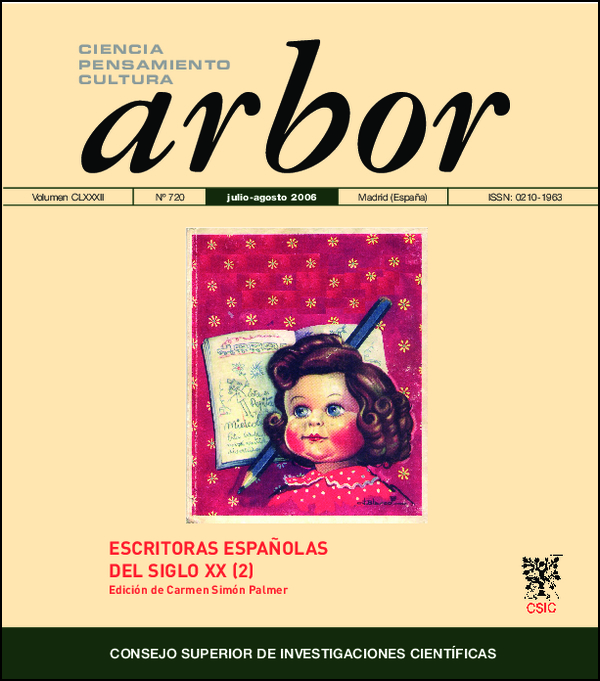Inconsciente genérico, feminismo y Nubosidad variable de Carmen Martín Gaite
DOI:
https://doi.org/10.3989/arbor.2006.i720.48Keywords:
Feminism, Carmen Martín Gaite, Variable CloudAbstract
In a context of marked tensions between gynocritics and contemporary Spanish women writers, Carmen Martín Gaite’s novel Nubosidad variable (Variable Cloud,1992) stands out as a curious paradox. As is well known, Martín Gaite repeatedly declared not to be a feminist and even scorned women who fought for equality between both sexes. This article argues that Nubosidad variable, however, constitutes one of the best examples of a consciously feminist text. In this novel Martín Gaite applies some of the most prominent paradigms of feminist literary theory, such as the construction of a non-linear and a-chronological narration (Julia Kristeva), the attempt to create a “language of the body” (Helène Cixous), the foregrounding of a mother-daughter bond (Luisa Muraro), as well as the use of female writing as a means of self-discovery (Elaine Showalter).
Downloads
References
Blanco, Alda (1998): “Teóricas de la conciencia feminista”, en La mujer en los discursos de género, Catherine Jagoe, Alda Blanco y Cristina Enríquez de Salamanca, eds. Barcelona: Icaria, 445-466.
Blau duPlessis, Rachael (1985): Writing Beyond the Ending: Narrative Strategies of Twentieth-Century Women Writers. Bloomington: Indiana University Press.
Carbayo Abengózar, Mercedes (1998): Buscando un lugar entre mujeres: buceo en la España de Carmen Martín Gaite. Malaga: Universidad de Málaga.
Cibreiro, Estrella (2000): “El mismo mar de todos los veranos y Nubosidad variable: hacia la consolidación de una identidad femenina propia y discursiva”, Letras Peninsulares, 13.2-3: 581- 607.
Cruz, Jacqueline (1995). “De El cuarto de atrás a Nubosidad variable: la conquista de la autoridad escrituraria en la obra de Carmen Martín Gaite”, en La nueva mujer en la escritura de autoras hispánicas. Juana Arancibia, Yolanda Rosas y María Rosa Lojo, eds. Montevideo: Instituto Literario y Cultural Hispánico, 125-42.
Etxebarria, Lucía (2000): La Eva futura. Barcelona: Destino.
Freixas, Laura (2000): Literatura y mujeres. Barcelona: Destino.
Lerner, Gerda (1986): The Creation of Feminist Consciousness. Oxford: Oxford University Press.
Martín Gaite, Carmen (1955): El balneario, Madrid: Afrodisio Aguado.
Martín Gaite, Carmen (1958): Entre visillos. Barcelona: Destino.
Martín Gaite, Carmen (1978): El cuarto de atrás. Barcelona: Destino.
Martín Gaite, Carmen (1983): EL cuento de nunca acabar. Madrid: Trieste.
Martín Gaite, Carmen (1982): “Las mujeres liberadas”, en La búsqueda de interlocutor y otras búsquedas. Barcelona: Destino.
Martín Gaite, Carmen (1992): Nubosidad variable. Barcelona: Anagrama.
Martín Gaite, Carmen (1993): Desde la ventana. Madrid: Espasa Calpe.
Muraro, Luisa (1991): L’ordine simbolico della madre. Roma: Editori Riuniti. Oropesa, Salvador (1995): “Nubosidad variable de Carmen Martín Gaite: una alternativa ética a la cultura del pelotazo”, Letras Peninsulares, 8.1: 55-72.
Pérez, Janet (1994-1995): “Nubosidad variable: Carmen Martín Gaite and Women’s Words”, Revista de Literatura Hispánica, 40-41: 301-315.
Pittarello, Elide (1993): “Carmen Martín Gaite: Nubosidad variable e altre incertezze”, Rassegna Iberística, 46: 87-92.
Riera, Carme (1982): “Literatura femenina: ¿Un lenguaje prestado?”, Quimera, 18: 9-12.
Showalter, Elaine (1981): “Feminist Criticism in the Wilderness”,Critical Inquiry, 179-205. doi:10.1086/448150
Zatlin Boring, Phyllis (1977): “Carmen Martín Gaite, Feminist Author”, Revista de Estudios Hispánicos, 11.3: 323-338.
Downloads
Published
How to Cite
Issue
Section
License
Copyright (c) 2006 Consejo Superior de Investigaciones Científicas (CSIC)

This work is licensed under a Creative Commons Attribution 4.0 International License.
© CSIC. Manuscripts published in both the printed and online versions of this Journal are the property of Consejo Superior de Investigaciones Científicas, and quoting this source is a requirement for any partial or full reproduction.
All contents of this electronic edition, except where otherwise noted, are distributed under a “Creative Commons Attribution 4.0 International” (CC BY 4.0) License. You may read the basic information and the legal text of the license. The indication of the CC BY 4.0 License must be expressly stated in this way when necessary.
Self-archiving in repositories, personal webpages or similar, of any version other than the published by the Editor, is not allowed.














